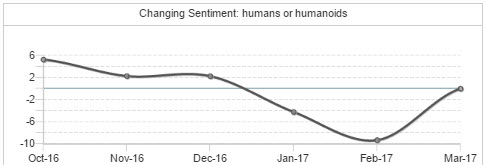Future Humans

There will be a global decline in the proportion of the populations in paid employment in the coming decades resulting from automation and other technological innovations. Robots and technological advances will take more than 5 million jobs from humans over the next 5 years.
What is changing?
- 2017 will be the year computers and humans start talking to each other.
- The next 20 years likely will not see machines exhibit broadly-applicable intelligence comparable to or exceeding that of humans.
- By 2020, humans will have more conversations with chatbots than with their spouses.
- Machine intelligence will be on par with humans and that by 2045.
- Supersmart robots will outnumber humans and more than a trillion objects will be connected to the internet within three decades.
- The US has another 10 to 15 years in which there will be a role for humans.
- Humans born 50 years from now (assuming the robots don't take over first) will make current humans seem pretty lacklustre by comparison.
- By 2018, 30 percent of all new robotic deployments will be smart collaborative robots that operate three times faster than today's robots and are safe for work around humans.
- Any delivery company looking to replace humans with robots will have to catch Uber.
- Humans must become cyborgs to stay relevant. Brain implants will follow within the next 10 to 15 years.
- 83 percent of jobs that pay less than $20 an hour are under threat from automation.
- Just over half of menial office jobs will no longer be carried out by humans within 20 years.
- Roughly half of today's work activities could be automated by 2055.
- Intelligent agents and related robots will only have eliminated 6% of jobs by 2021.
- The disruption in employment will not be uniform; some countries will be hit harder than others. The US has another 10 to 15 years in which there will be a role for humans. The number of jobs will actually increase in the US and Europe before it decreases.
- In the new World there will still be a great deal for highly-trained humans to do.
- Automation will both replace and supplement human labor.
- Getting robots to work on laborious tasks will allow humans to concentrate more cognitive tasks.
- Human trainers will be needed to demonstrate complex tasks for robots to learn and perform.
- Humans will lose their economic and military usefulness.
- Noted futurist Ray Kurzweil forecasts the singularity for 2045.
Space
- Humans will begin living and working in orbit during the next five years.
- Survival on Mars will largely be hinged on how efficiently humans can adapt.
- Putting humans on Mars will lead to more scientific discovery.
- Americans can expect a lunar habitat by the 2020s and humans in Mars orbit in 2032.
- There are currently too many risks to safely send humans on a round trip to Mars.
- Astronauts who travel to Mars and stay there long enough for their bodies to adjust to the lower level of gravity will likely experience permanent changes in circulation, muscle strength, and bone density.
- NASA will develop the capabilities necessary to send humans farther into space than ever before.
Biodiversity
- Only bold changes will substantially diminish the imminent possibility of humans consuming many of the world's wild mammals to the point of functional or global extinction.
- GM crops could pose a health risk by "transferring" their modified genes to animals or humans.
Health
- The chance of a naturally occurring disease causing the extinction of the human race before 2100 is .05%, or 1 chance in 2,000.
- Molecular repair, gene therapy, pharmaceuticals, and organ replacement will eventually enable humans to have indefinite lifespans.
- Unmodified humans will increasingly be unable to compete.
Implications
Robots
- A team of researchers from MIT's Computer Science and Artificial Intelligence Laboratory and Boston University are working on a system that could enable humans to communicate with robots with just their thoughts.
- By 2050 people could have sex with robots more often than with humans because the technology will be so advanced that any possible difference will disappear.
- Marriage between humans and robots could start around 2050.
- Industrial and personal service robots could outnumber humans by the 2040s.
- Humans are going to need to get used to working with and alongside automated systems as they do on manufacturing floors today with tools like Universal Robots' UR10 and the Robotiq Three Finger Grippers.
- Bestselling author and futurist Martin Ford predicts a working-class revolt against the robot economy.
- Unaligned AIs will not want to join some kind of global pact to all wait for the humans to decide.
Wages
- Governments will need to pay non-working humans a liveable wage.
Deep space missions
- The development of a plasma rocket could greatly accelerate space travel for humans and cargo on deep space missions.
Sentiment Analysis

Forecasts: